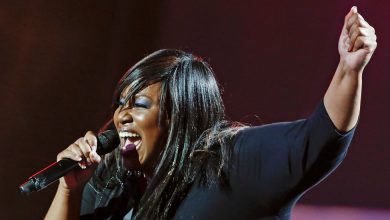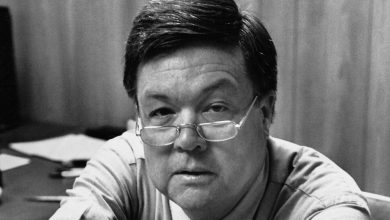In Kentucky, a Maestro of the People

On a muggy July night at an amphitheater in suburban Kentucky, the conductor and composer Teddy Abrams — sporting black jeans, camouflage sneakers and a bouncy mop of golden curls — took the podium and began to evangelize.
It was the final stop on the Louisville Orchestra’s summer tour across Kentucky, and Abrams, the ensemble’s 36-year-old music director, paused to speak to the crowd of roughly 900 in Bardstown, 40 miles or so south of Louisville, about his mission.
He told the audience — teenagers in tie-dye, retirees snacking on nachos and workers from nearby Bourbon distilleries among them — that he wanted to use music to “bring people together across all backgrounds.” Invoking his idol, the eminent conductor Leonard Bernstein, he said music was a universal language: “We have to do something with it.” He spoke of the need for Kentucky to promote its rich cultural traditions.
“This is your Louisville Orchestra, everyone,” he said. “Kentuckians know good music. We’ve made a lot of the music that the world loves, invented entire genres right here in our state. That’s what this is all about — sharing the incredible music-making that takes places in Kentucky.”
During his nine years at the helm of the Louisville Orchestra, Abrams has helped the 86-year-old ensemble emerge from a period of turmoil to reclaim its reputation as one of the most innovative in the United States.
And he stands out for another reason. While many modern maestros lead jet-set lives, spending only as much as time in one place as contractually required, Abrams, a California native, has broken the mold, putting down roots in Kentucky and embarking on an ambitious project to make the orchestra part of daily life for Kentuckians.
He lives in a house near downtown Louisville, where he regularly hosts musicians, activists, city officials and entrepreneurs, and rides a bicycle around town. (He finally got a driver’s license in October.) He writes music honoring local figures, including a “rap opera” about Muhammad Ali (a musical, “Ali,” by Abrams and the actor and director Clint Dyer, is set to premiere in Louisville next year and is aimed for Broadway in 2025). He has expanded the orchestra’s public efforts, starting a rap program for young people; founding a creator corps that invites artists from around the country to embed themselves in Kentucky; and leading a two-year statewide tour, which began in May, including the stop in Bardstown.
His approach stands in stark contrast to that of many music directors, who often take on full-time commitments to several orchestras at once and can live thousands of miles from their ensembles.
Abrams says that conductors too often operate at a distance from their communities, missing an opportunity to build connections.
“We expect mayors and university presidents and police chiefs to be in the city,” he said. “I think that the conductor of the orchestra should be in that same category of civic leader. Because if they’re not, what does it say to the people of that town?”
Abrams’s vision has drawn attention at a time when many arts organizations are looking to forge closer ties with residents and communities. His approach recalls that of Bernstein, who as music director of the New York Philharmonic popularized a series of concerts for young people and was credited with helping make classical music accessible to the public.
Abrams also draws inspiration from his mentor, Michael Tilson Thomas, the former music director of the San Francisco Symphony, who studied with Bernstein and has also initiated music education efforts, including the popular “Keeping Score” television series.
Thomas, who has known Abrams since he was a child, said his protégé had created “a very natural space for people to feel comfortable inside of the music.”
“He is extraordinarily devoted to helping people better understand what the music is all about, and what they’re all about,” Thomas said. “I’ve never really seen anything quite like it, and it fills me with an enormous sense of hope.”
Abrams’s success in Louisville has fueled speculation that he might be tapped for a more prominent post, perhaps in Los Angeles or elsewhere. He doesn’t rule out such a move, he said, but at the same time he doesn’t feel pressure to climb the ladder.
“I never thought I’m just going to stay here until a larger orchestra comes along, until I can get a ‘better’ gig,” he said. “That’s not the calling. I was brought here to do something for this place.”
Born in Berkeley, Calif., the son of lawyers, Abrams played piano and clarinet as a child. He was drawn to conducting after seeing Thomas lead an all-Gershwin program with the San Francisco Symphony when he was 9. He wrote a letter to the famed maestro soliciting advice — and lessons.
Thomas urged him to seek out 20th-century composers, including Stravinsky, Prokofiev and Bartok, in addition to Beethoven and Mozart, and told him to “keep your ears open.” (Thomas’s reply, framed, now hangs in Abrams’s Louisville bedroom.)
Soon Abrams was studying with Thomas, who offered guidance on life as well as music. When he saw Abrams, then a teenager, with a pencil behind each ear, he counseled him that “one pencil is endearing; two are eccentric.”
Thomas said that Abrams was eager from the start: “He always had this tremendous and thorough enthusiasm for music in all of its different forms.”
At 11, he enrolled at community college because his family thought it would be a better fit than traditional schools (“I was a diminutive kid who related to adults,” he said). At 18, he graduated from the San Francisco Conservatory of Music and went onto the Curtis Institute of Music in Philadelphia, becoming one of the youngest conducting students to enroll there.
Abrams seemed destined for a traditional career, earning plum posts as a fellow at the New World Symphony in Miami, co-founded by Thomas, and as an assistant conductor at the Detroit Symphony under its then-music director, Leonard Slatkin.
Then the Louisville Orchestra, which had been searching for years for a replacement for Jorge Mester, its veteran conductor, invited him for an audition. Abrams said he felt an immediate connection with the orchestra, and in 2014, when he was 27, he became the youngest music director in Louisville’s history.
He took up full-time residence in the city, buying a sprawling two-story home in the trendy NuLu neighborhood, and furnishing it with two pianos, a Hammond organ, a keyboard and other instruments. Abrams, who is also fluent in genres like jazz, swing and blues, sometimes took his keyboard to the street to entertain passers-by.
When he arrived, the orchestra was still feeling the pain of having declared bankruptcy in 2010 in the aftermath of the global financial crisis. At the time, the orchestra made cuts to musicians’ pay and reduced the size of the ensemble to 55 from 71.
“We were left with ashes,” said Kathleen Karr, the principal flutist. “His ability to make us feel so worthy of all his ideas gave us new hope.”
Abrams set out to improve morale and to rethink the orchestra’s place in the community.
“The orchestra was in such a place of questioning and an identity crisis that it meant when I came here it was an open book,” he said. “We could write the story in a new way.”
The Louisville ensemble had a reputation for experimentation going back to the 1940s, when the city’s mayor, Charles Farnsley, a fan of composers like Stravinsky and Villa-Lobos, came up with a plan to save the orchestra by commissioning works by living composers. In the decades that followed, as the orchestra premiered and recorded hundreds of new pieces, few ensembles could match Louisville’s ambition.
Abrams has sought to resurrect that legacy, inviting composers and artists to Louisville for residencies and commissioning more than 70 works, including pieces by rappers and R&B stars. He has also presented many of his own works, including a piece about Mammoth Cave, in central Kentucky, which premiered this spring inside the cave with the renowned cellist Yo-Yo Ma.
The star pianist Yuja Wang, a classmate at Curtis who often enlisted Abrams to accompany her while rehearsing concertos, went to Louisville last year for the premiere of a piano concerto that Abrams wrote for her, which combines jazz, funk, big band and television and movie music. “He has this way of expanding on every thought and making it even more imaginative,” she said. “He always has a clear vision of what he wants.”
As he enters his 10th season in Louisville, Abrams is keeping the focus on community, amicably playing the role of musical ambassador (a photo of him conducting greets visitors at the Louisville airport).
One day this summer, he spent time with a group of students in the hip-hop program, a joint project of the orchestra and the education group Hip-Hop N2 Learning. When the teenagers invited him to take part in a dance video they would post on TikTok, he agreed with some hesitation, watching intently as they taught him the routine.
“I’ve never done this before,” he said. “I’m worried this will be the white guy cannot dance situation.”
“Teddy, it’s so easy!” the students exclaimed, and he began to sway his hips and cross his arms.
When they finished, Abrams turned to the students. “Let me know when we get to a million views,” he said.
Craig Greenberg, the mayor of Louisville, said Abrams often showed up in unexpected places to promote the orchestra. Several years ago, he said, Abrams brought a small band of orchestra players to perform at a wrestling match.
“He’s always looking to break down the barriers,” Greenberg said, “so that more people have access to art and have an entry point to begin to enjoy the arts even more.”
The pandemic, which forced the cancellation of in-person concerts, brought new challenges. But Abrams and the orchestra’s chief executive, Graham Parker, have kept the organization’s finances relatively stable. The annual budget has more than doubled to about $12 million over the past decade, and donations and grants have risen sharply.
Still, there is work to be done: The orchestra’s audiences remain predominantly white, as do its players, despite the fact that about 24 percent of Louisville’s residents are Black and about 7 percent are Hispanic.
A year after Breonna Taylor, a Black medical worker in Louisville, was shot and killed by police officers, Abrams and the orchestra joined forces with Jecorey Arthur, a rapper and City Council member, for a virtual program that included a Ravel piano concerto, as well as Black spirituals and a hip-hop track.
“He’s always very intentional,” Arthur said, “not just musically, but also socially and politically, and knows that he is a part of something that is bigger than him as an individual.”
Abrams, who has signed with Louisville through at least the 2024-25 season, acknowledges that he has lofty ideals and that he may at some point be tempted to try his community-driven approach elsewhere.
But for now, he says, he is content where he is.
“If Louisville becomes a destination city for composers, and they all start leaving Williamsburg and L.A. and Nashville and wherever they are, then the question is reversed,” he said. “Why would I leave? Why would you leave something if you actually helped make it?”




